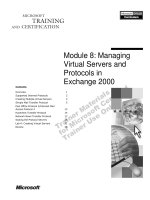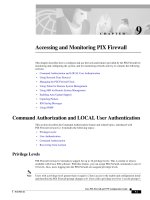Tài liệu Developing and Managing Engineering Procedures docx
Bạn đang xem bản rút gọn của tài liệu. Xem và tải ngay bản đầy đủ của tài liệu tại đây (63.38 KB, 9 trang )
1
Where does it say that you have to develop, change, review,
approve, and follow Engineering Procedures?
1
Introduction
Well, if you are or want to be in compliance with ISO 9000
regulations, then the following sections apply to you.
2 Developing and Managing Engineering Procedures
ISO 9001 Sec. 4.4, Design Control:
The supplier shall establish and maintain procedures to
control and verify the design of the product in order to
assure that the specified requirements are met.
ISO 9001 Sec. 4.5, Document Control; Subsection 4.5.1, Document Ap-
proval and Issue:
The supplier shall establish and maintain procedures to
control all documents and data that relate to the
requirements of this international standard. These
documents shall be reviewed and approved for adequacy
by authorized personal prior to issue. This control shall
ensure that:
a) The pertinent issues of appropriate documents
are available at all locations where operations
essential to the effective of the quality system
are performed.
b) Obsolete documents are promptly removed
from all points of issue or use.
ISO 9001 Sec. 4.5, Document Control; Subsection 4.5.2, Document Changes/
Modifications:
Changes to documents shall be reviewed and approved by
the same functions/organizations that performed the original
review and approval unless specifically designated
otherwise. The designated organizations shall have access
to pertinent background information upon which to base
their review and approval.
Where practicable, the nature of the change shall be
identified in the document or appropriate attachments.
A master list or equivalent document control procedure
shall be established to identify the current revision of
documents in order to preclude the use of non-applicable
documents.
Introduction 3
Documents shall be re-issued after a practical number of changes
have been made.
Besides ISO 9000 there are several other reasons why you will
need to document your engineering operation:
♦ Customers will impose their own documentation
requirements on you.
♦ Sometimes you will need to work to Military Standards.
♦ The Food and Drug Administration have their current
good manufacturing practices (cGMP ).
♦ If you are going to do business with international
suppliers, ISO 9000 is the way to go.
♦ Or it is just a good idea?
Regardless of the reason for which you are documenting your
operation, the unexpected benefits will be greater operational efficiency,
increased profitability and savings in administrative costs, and improve-
ments in marketing and sales activity. Putting together an engineering
documentation system is a great aid in determining exactly how you are
operating now, where you need to improve, and the best way to carry out
your processes.
This guide book consists of twenty-five engineering procedures
and five forms that can be used by any company to establish an engineering
procedural documentation system. The first part of this book covers a new
company setting up an engineering procedures (paper based) documenta-
tion system and Ch. 7 covers an electronic database. The paper based
system uses engineering procedure manuals as a method of distributing
new and revised procedures to end-users. All of the methods shown in this
book can be tailored to fit each company’s unique operation. This book is
written in such a way that those employees responsible for writing and
managing engineering procedures can use it as a guideline to perform their
daily tasks. The table of contents follows the normal sequence of an
engineering procedure documentation process and documentation methods
are established in each of the chapters. The document formats and num-
bering systems can be used by most companies, and they are acceptable
per ISO 9000 guidelines. Several of the engineering procedures include
forms that will aid in the information gathering process.
4 Developing and Managing Engineering Procedures
1.1.0 ENGINEERING PROCEDURES CASE STUDY
Once upon a time there was a manufacturing company that was
manufacturing products long before ISO 9000 regulations ever existed.
They were documenting some of their procedural methods but they still did
not have complete confidence that their process was as good as it could be.
When ISO 9000 regulations came into being, they stepped up their engi-
neering procedures writing activities to be compliant with the guidelines.
The existing procedures were analyzed for quantity, and evaluated
for quality and availability. After performing an analysis of the document
system, the consensus was that there were not enough procedures and they
were all different because there was not a standard format in place to
follow.
Some of the documents were not even engineering procedures. As
you can imagine, the people who were tasked with writing engineering
procedures had a full time job. They could only write them in their spare
time. As far as control goes, it would take from two to six months to get an
engineering procedure through the system. After some time had passed,
their documentation system received a boost when they organized a
continuous improvement team to reengineer their engineering procedures
system. An analysis and summary were prepared and, as a result, correc-
tive action plans were developed and implemented. The document system
was modernized and within six months the company had an easy-to-use
and easy-to-maintain documentation system. This is where this book
comes in, it covers everything it takes to develop and manage engineering
procedures and their associated documentation.
Introduction 5
1.2.0 ENGINEERING PROCEDURES MANAGEMENT
This book shows how to develop and manage engineering proce-
dures and their associated documents for all engineering department func-
tions (Fig. 1.1). The engineering department is responsible for generating
and maintaining procedures governing its day-to-day operations. The re-
leased procedures will be contained in manuals for ease of use and revision.
Each manager will approve new and revised procedures for his/her particular
function. Managers of other departments affected by the procedure must
also approve the documents. The engineering department is also responsible
for the producing, distributing, and maintaining procedure manuals. This
book is written in the order that documentation functions are carried out.
ü First, establish a procedures writing group, then identify
which documents need to be developed.
ü Second, establish a method for writing each type of
document and develop formats and contents.
ü Third, after documents are approved they will be
released into engineering document control. Engineering
document control will produce the engineering
procedure manuals and distribute them to end-users.
ü Fourth, a change control system will need to be
developed to maintain the integrity of the system.
Figure 1.1. Engineering department organization.
Research
and
Development
Engineering
Analysis
Drafting
Design
Engineering
Procedure
Writers
Technical
W riting
Change
Control
Document
Control
Engineering
Department
Organization









